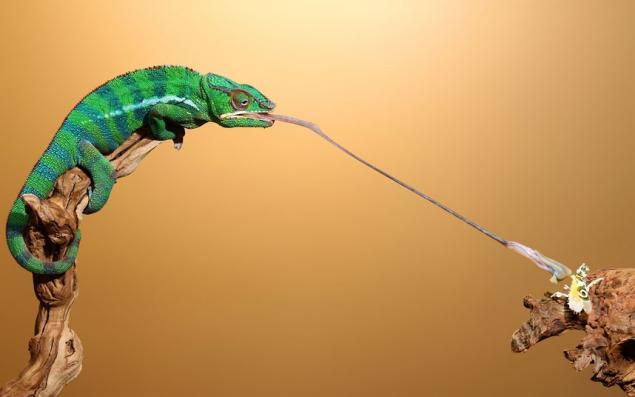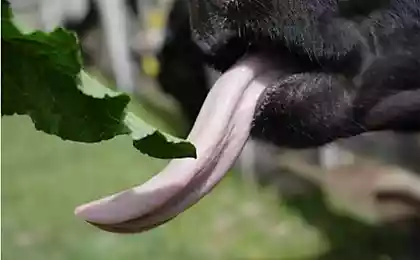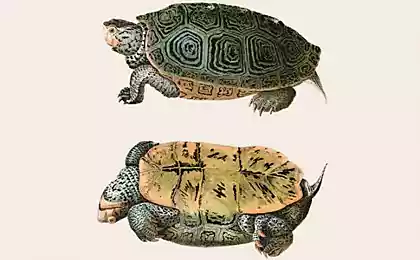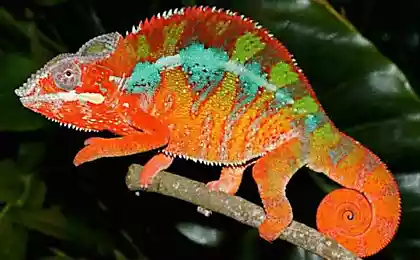729
Perfect silent killer - chameleon
A method of prey capture these animals, scientists were able to explain just now

you see in this photo of a talented hunter? No? And it is.
Chameleons - amazing creatures. Their vision, skin structure, the principle of hunting - all unique. Chameleon looks a little strange, even funny. But it is to humans. A chameleon in nature - a dangerous killer, quiet and accurate. However, the chameleon hunts only in relatively small insects, which it is able to swallow. Once chameleon sees prey, he throws a long and very sticky at the end of the tongue (the reason for this stickiness discussed below). Language of a chameleon - one of the most developed organs of the body. We can say that this is his sixth limb (if you count his prehensile tail fifth). With tongue chameleon is able to capture and swallow prey to one-third of the animal's weight. And all this - without the slightest movement of the body, works only language.
How exactly does a chameleon captures the victim remained a mystery for many years. It is difficult to understand even what it was like an animal throws his tongue as fast at such distances (two body lengths in a fraction of a second). And then, as the victim is captured and returned to the mouth of a chameleon - it is even more difficult question. As it turned out, the reason for the success of silent hunting - in sticky chameleon tongue. He did not just tacky, and very sticky.
This property of language is due to the viscosity of saliva chameleon. It is 400 times more viscous than human saliva. Under certain conditions, the substance behaves as an elastic solid, rather than as a liquid. This is - the key to understanding
«linguistic capture" mechanism. Saliva is produced in very small quantities by special glands language. Scientists were able to measure the viscosity of the fluid, despite all the difficulties. Using bait chameleon managed to get thrown language, hitting on a microscope slide. On the glass imprinted saliva. After that, once the second phase of the experiment - measurement of viscosity. The researchers took advantage of the second glass, coated with a control fluid, the viscosity of which is known. Thereafter tiny metal balls began to roll on the first and second fluids. This glass was tilted at a certain angle. The maximum angle at which the ball not rolled, but remained in the test fluid, provides a measure of the viscosity of the liquid.
"Unexpectedly high viscosity allows saliva suggests that the victims adhere to the chameleon's tongue due to viscous adhesion," says study leader Dammon Pascal (Pascal Damman). "But even the knowledge of this value is not enough to determine the strength of adhesion viscous. we used a dynamic model of the retraction phase for measuring the adhesion strength. "
Scientists found out that the impact of language on the insect expands the language and the area of contact with the victim increases. This means that significantly increases grip and insect from the tongue surface. Despite the fact that the language quickly returned, adhesive force enough to the victim "fell." "A viscous adhesion - an effective way to hold even a very big sacrifice", - he says. Viscous fluid is produced only during ejection language.
Viscosity Measurement of saliva chameleon helped confirm one of the assumptions about how a chameleon keeps production at the tip of your tongue. Back in the 50s of the last century was created the "theory of adhesion," according to which the victim simply stick to some adhesive on the tip of the chameleon's tongue. After this assumption is rejected as untenable, considering that just a chameleon can throw out of the mouth inedible object, then the saliva is not to blame. Confirmation was received from the scientists who conducted the experiment with an animal blocking the nerves responsible for the operation of language. After blocking nerve channels, control the operation of the tip of the tongue, the chameleon were unable to capture the victims. Yes, language was thrown out, but production is not stuck to it.
Now it turned out that right still scholars who wrote about the chameleon in the 50s. Interestingly another point. The major victims of the chameleon can easily let go (if it is very strong production) due to the fact that the language when you dispose takes a certain shape, similar to a bowl. It was called the "suction cup". Small insects are immediately in the "bowl" in the capture. But large prey tongue only partially covered.
Language is emitted during operation of the two muscles on both sides of the hyoid bone chameleon. He returned in the form of a spiral scroll.
How fast is the chameleon?
This year, the American Brown University biologists have decided to determine how fast the chameleon as a hunter. They selected 20 species of chameleons and started filming the capture of prey representative of each type of speed camera (up to 3000 frames per second). As it turned out, the average discharge process language is just 1/20 of a second. Return to the starting position of language with the victim takes about half a second. For three seconds chameleon can identify and catch insects to 4. If a chameleon does not hunt, held a special language of the bone of the lower jaw.

As for the effectiveness of various types of hunting, the hunters were the most deadly type of chameleon Rhampholeon spinosus. their body size is only four centimeters, but the tongue is ejected by a distance of 2.5 times the length of the animal's body. Language thus gaining speed at 100 km / h in just a hundredth of a second.
Slightly less effective hunters are Brookesia superciliaris, Rieppeleon brevicaudatus and Trioceros hoehnelii. They have a long body language twice. And the least deadly for the victim is a giant chameleon Furcifer oustaleti, growing up to 60 centimeters in size and more.
According to experts, the accuracy of the throw small species of chameleons tongue due to high energy costs. If you miss the little chameleon, he will have to gather strength for the next attack. But a large chameleon enough energy to re-cast.
What else do chameleon?
Of course, change the color and pattern of the body. This makes the animal even more deadly to its victims. The ability to change the color associated with the structure of the chameleon's skin. In the outer layer of the skin is placed a large number of chromatophores cell. These cells contain the pigment grains of different colors, including black, dark brown, red and yellow. The combination of these colors can stain your skin chameleon in many different shades.

Also chromatophores, chameleons and has special cells with crystals inside, which can reflect and refract light. And in the deepest layer of subcutaneous chameleon scientists have discovered crystals that help the animal to reflect infrared radiation. With these cells chameleon may reflect infrared maintaining body temperature in the heat.
The animal can quickly change the body color from black to off-white. This can change the color of the skin is not all, but some of its parts.
Coloration varies under the influence of various factors, including the environment and the condition of the animal. Some species of chameleons change color not to escape, and to communicate with members of their own species.
Source: geektimes.ru/post/277528/

you see in this photo of a talented hunter? No? And it is.
Chameleons - amazing creatures. Their vision, skin structure, the principle of hunting - all unique. Chameleon looks a little strange, even funny. But it is to humans. A chameleon in nature - a dangerous killer, quiet and accurate. However, the chameleon hunts only in relatively small insects, which it is able to swallow. Once chameleon sees prey, he throws a long and very sticky at the end of the tongue (the reason for this stickiness discussed below). Language of a chameleon - one of the most developed organs of the body. We can say that this is his sixth limb (if you count his prehensile tail fifth). With tongue chameleon is able to capture and swallow prey to one-third of the animal's weight. And all this - without the slightest movement of the body, works only language.
How exactly does a chameleon captures the victim remained a mystery for many years. It is difficult to understand even what it was like an animal throws his tongue as fast at such distances (two body lengths in a fraction of a second). And then, as the victim is captured and returned to the mouth of a chameleon - it is even more difficult question. As it turned out, the reason for the success of silent hunting - in sticky chameleon tongue. He did not just tacky, and very sticky.
This property of language is due to the viscosity of saliva chameleon. It is 400 times more viscous than human saliva. Under certain conditions, the substance behaves as an elastic solid, rather than as a liquid. This is - the key to understanding
«linguistic capture" mechanism. Saliva is produced in very small quantities by special glands language. Scientists were able to measure the viscosity of the fluid, despite all the difficulties. Using bait chameleon managed to get thrown language, hitting on a microscope slide. On the glass imprinted saliva. After that, once the second phase of the experiment - measurement of viscosity. The researchers took advantage of the second glass, coated with a control fluid, the viscosity of which is known. Thereafter tiny metal balls began to roll on the first and second fluids. This glass was tilted at a certain angle. The maximum angle at which the ball not rolled, but remained in the test fluid, provides a measure of the viscosity of the liquid.
"Unexpectedly high viscosity allows saliva suggests that the victims adhere to the chameleon's tongue due to viscous adhesion," says study leader Dammon Pascal (Pascal Damman). "But even the knowledge of this value is not enough to determine the strength of adhesion viscous. we used a dynamic model of the retraction phase for measuring the adhesion strength. "
Scientists found out that the impact of language on the insect expands the language and the area of contact with the victim increases. This means that significantly increases grip and insect from the tongue surface. Despite the fact that the language quickly returned, adhesive force enough to the victim "fell." "A viscous adhesion - an effective way to hold even a very big sacrifice", - he says. Viscous fluid is produced only during ejection language.
Viscosity Measurement of saliva chameleon helped confirm one of the assumptions about how a chameleon keeps production at the tip of your tongue. Back in the 50s of the last century was created the "theory of adhesion," according to which the victim simply stick to some adhesive on the tip of the chameleon's tongue. After this assumption is rejected as untenable, considering that just a chameleon can throw out of the mouth inedible object, then the saliva is not to blame. Confirmation was received from the scientists who conducted the experiment with an animal blocking the nerves responsible for the operation of language. After blocking nerve channels, control the operation of the tip of the tongue, the chameleon were unable to capture the victims. Yes, language was thrown out, but production is not stuck to it.
Now it turned out that right still scholars who wrote about the chameleon in the 50s. Interestingly another point. The major victims of the chameleon can easily let go (if it is very strong production) due to the fact that the language when you dispose takes a certain shape, similar to a bowl. It was called the "suction cup". Small insects are immediately in the "bowl" in the capture. But large prey tongue only partially covered.
Language is emitted during operation of the two muscles on both sides of the hyoid bone chameleon. He returned in the form of a spiral scroll.
How fast is the chameleon?
This year, the American Brown University biologists have decided to determine how fast the chameleon as a hunter. They selected 20 species of chameleons and started filming the capture of prey representative of each type of speed camera (up to 3000 frames per second). As it turned out, the average discharge process language is just 1/20 of a second. Return to the starting position of language with the victim takes about half a second. For three seconds chameleon can identify and catch insects to 4. If a chameleon does not hunt, held a special language of the bone of the lower jaw.

As for the effectiveness of various types of hunting, the hunters were the most deadly type of chameleon Rhampholeon spinosus. their body size is only four centimeters, but the tongue is ejected by a distance of 2.5 times the length of the animal's body. Language thus gaining speed at 100 km / h in just a hundredth of a second.
Slightly less effective hunters are Brookesia superciliaris, Rieppeleon brevicaudatus and Trioceros hoehnelii. They have a long body language twice. And the least deadly for the victim is a giant chameleon Furcifer oustaleti, growing up to 60 centimeters in size and more.
According to experts, the accuracy of the throw small species of chameleons tongue due to high energy costs. If you miss the little chameleon, he will have to gather strength for the next attack. But a large chameleon enough energy to re-cast.
What else do chameleon?
Of course, change the color and pattern of the body. This makes the animal even more deadly to its victims. The ability to change the color associated with the structure of the chameleon's skin. In the outer layer of the skin is placed a large number of chromatophores cell. These cells contain the pigment grains of different colors, including black, dark brown, red and yellow. The combination of these colors can stain your skin chameleon in many different shades.

Also chromatophores, chameleons and has special cells with crystals inside, which can reflect and refract light. And in the deepest layer of subcutaneous chameleon scientists have discovered crystals that help the animal to reflect infrared radiation. With these cells chameleon may reflect infrared maintaining body temperature in the heat.
The animal can quickly change the body color from black to off-white. This can change the color of the skin is not all, but some of its parts.
Coloration varies under the influence of various factors, including the environment and the condition of the animal. Some species of chameleons change color not to escape, and to communicate with members of their own species.
Source: geektimes.ru/post/277528/
She made an incision along the entire length of eggplants, to treat all the best summer snack!
Rod, in which we came: Why is it important to preserve the roots and traditions multiply






















